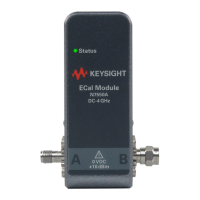Electronic Calibration Modules Reference Guide 4-15
Use, Maintenance, and Care of the Devices
Gaging Connectors
Gaging Technique
1. Connect and torque the device being measured to the gage.
2. Gently tap the barrel of the gage with your finger to settle the gage
reading.
3. Type-N and 7 mm: Read the gage indicator dial. If the needle has moved
clockwise, the center conductor is protruding by an amount indicated by
the black numbers. If the needle has moved counterclockwise, the center
conductor is recessed by an amount indicated by the red numbers. For
more on 7 mm connectors, See also, “Gaging Technique–7 mm Gage” on
page 4-16.
1.85/2.4/2.92/3.5 mm: Read the gage indicator dial. Read only the black
± signs; not the red ± signs.
4. For maximum accuracy, measure the connector a minimum of three times
and take an average of the readings. After each measurement, rotate the
gage a quarter-turn to reduce measurement variations that result from the
gage or the connector face not being exactly perpendicular to the center
axis.
5. Compare the average reading with the observed pin depth limits in the
tables located in “Typical Pin Depth Values” on page 5-21 for each type of
connector.

